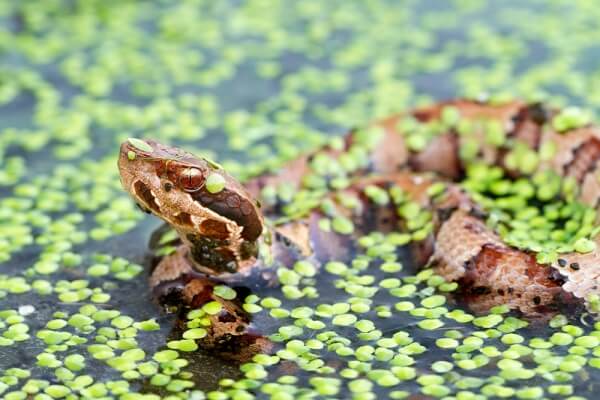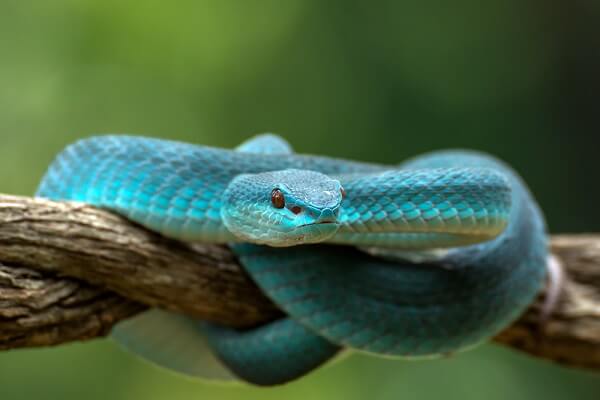
Pit viper is a common name used for species in the subfamily Crotalinae which share the defining feature of having infrared-sensing organs on the front of their face. “Pit viper” actually refers to over 150 different species that are found around the world and occupy habitats as diverse as the desert and the jungle – from Australia to Arizona. This group includes rattlesnakes, cottonmouths, copperheads, moccasins, the white-lipped pit viper, and many other pit vipers. A pit viper uses pit organs on its upper lip to find and identify prey. Much like eyes, pit organs detect electromagnetic radiation. However, these specialized organs sense infrared light instead of light in the “visible spectrum” – the wavelengths humans can see. Scientists studying pit vipers think that pit organs give them the ability to “see” body heat, and allows these snakes to judge the size and type of their prey. Interestingly, pit vipers also have special muscles around their fangs that allow them to better inject venom into their prey. Pit viper venom is different based on the species, and in many cases, it has evolved to be most effective on the prey species that the pit viper normally preys upon. Depending on the species, different components of pit viper venom include neurotoxins that cause paralysis, metalloproteinases that destroy tissue, and proteins that stop the blood from coagulating. Even for humans that are much larger, a bite from a pit viper can easily lead to death if untreated. Whether the pit viper fills you with fear or fascination, it is a perfect animal to help explain some important biological concepts. Let’s take a look at a few ways these snakes can help scientists understand other parts of biology. Pit organs are not only found in pit vipers. In fact, these special organs are also seen in boas and pythons. However, superficial analysis and genetic analysis both confirm that these organs evolved multiple times. The pit vipers seem to share a single genetic origin – all pit viper pit organs are similar in shape and structure. The pit organs of pit vipers consist of a deep pit, with a highly innervated membrane stretched across the opening. This highly sensitive area contains a large number of neurons, which receive a number of signals from the environment. Boas and pythons also have these pits, though there is no stretched membrane and the back of the pit is simply highly innervated. Boas and pythons typically have several pits on their upper lip, whereas pit vipers generally only have two large pits – one on each side of the head. These pit organs are so sensitive that a pit viper could be completely blinded and still have the ability to hunt and strike prey. In fact, this has been shown in lab experiments where pit vipers were temporarily blind-folded. All snakes were still able to accurately strike prey. This is one piece of a large body of evidence that suggests that pit vipers create a mental image with the information from its pit organs – making them as or more sensitive than eyes. The snakes may also use this sense to determine which areas are best for basking or for cooling off. Unlike most species of snakes that lay eggs, pit vipers are most commonly ovoviviparous. This means that eggs remain inside the female and develop for several months. When they are fully developed, the eggs hatch inside of the female, then wiggle their way out into the world. This method of reproduction carries several advantages over laying eggs. First off, the female can protect her eggs easily, since she carries them with her at all times. For snakes without powerful defenses, this might not be a great strategy. For example, if the female is eaten, all of her offspring die with her. But, pit vipers are not like other snakes. They have extremely powerful venom and are often decorated with warning coloration – or in the case of the rattlesnake a warning rattle. In concert with their powerful venom, this helps pit vipers scare off dangerous predators and making it safer to carry her eggs with her. Second, (because pit vipers are excellent at controlling their body temperature) the female can perfectly control the temperature of her eggs at all times. Laying eggs in a nest can be risky. Though the female may identify a nest site with the proper temperature before she lays her eggs, many different events can cause that site to become unsuitable long after the female has laid her eggs and left. That makes ovovivipary a beneficial strategy for the pit viper.
Kingdom
Animalia
Phylum
Chordata
Class
Reptilia
Order
Squamata
Family
Viperidae
Genus
22 genera in the subfamily Crotalinae
Species
150+ Species
Niche
Ambush Predator
Length
From 1 to 13 feet (30 cm – 4 m)
Weight
Up to 15 lbs (7 kg)
Lifespan
Varies by species
Social Structure
Typically solitary
Conservation Status
Least Concern to Endangered
Preferred Habitat
Variety of Habitats, depending on the species
Average Clutch Size
Between 2 and 86, depending on the species
Main Prey Species
Smaller rodents, reptiles, birds
Predators
Some mammals, large birds, humans
The Basics

Interesting Insights from the Pit Viper!
Pit Organs


Ovovivipary

